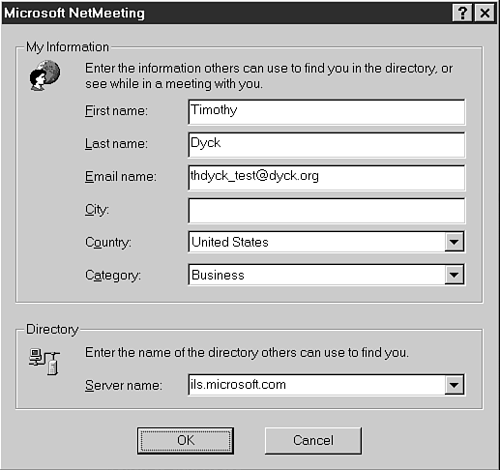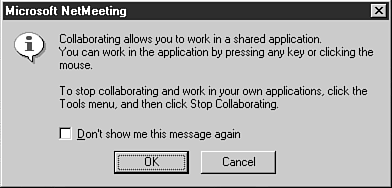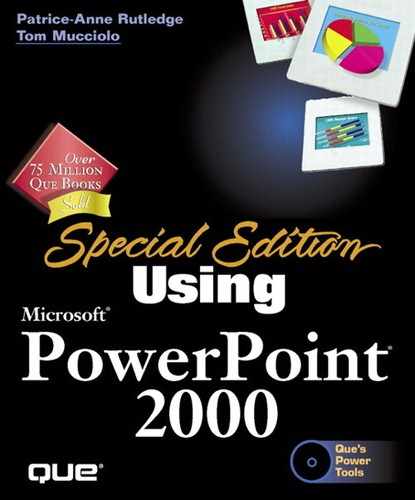Interactive Online Meetings
Besides presentation broadcasts, PowerPoint also provides a much more interactive way of sharing your ideas with others: online meetings.
PowerPoint has had interactive meeting features for some time; for example, you can use PowerPoint's Meeting Minder (Tools, Meeting Minder) to jot down minutes and action items while you're presenting to a group of people. Online meetings take the concept of interactive presentations online, where you can bring together a group of people from around the world to present your ideas and then discuss them.
Just as with presentation broadcasts, online meetings enable you to show your presentation to others live, including real-time audio and video commentary (audio and video can be sent to only one other person at a time unless you are using a special group conferencing server). However, online meetings also let your audience in on the action. Instead of passively watching your presentation, participants in a PowerPoint online meeting can jot down ideas on a shared whiteboard; interactively send messages back to you and the group; and even take control of the presentation in midstream, make some changes to the presentation, and then give control back to you so you can continue. Online meetings are much better suited to roundtable discussions and for immediate decision-making than presentation broadcasts are.
In this section, you'll learn how to start an online meeting and how to manage one after you've gotten going.
Starting an Online Meeting
The first step in starting an online meeting is to open the presentation you want to present in the meeting. Then choose Tools, Online Collaboration, Meet Now to get started. This starts the program PowerPoint uses for online meetings, a group collaboration tool called Microsoft NetMeeting (it's installed as part of Microsoft Office).
If you've run NetMeeting before, you'll be taken right to NetMeeting's Place A Call window.
If you haven't, you'll be asked to fill in some information about yourself (see Figure 17.19) so the other participants in the meeting will be able to connect up with you. Type in your name and email address (both are required), and choose a NetMeeting directory server in the Server name box. You can choose any one you want from the list, or you can type in your company's private NetMeeting directory server (ask your network administrator for its name). All the people that will be joining this meeting have to log in to the same NetMeeting server, however, so you'll have to let your audience know which server to use ahead of time.
Tip
You don't have to log in to a directory server if you don't want to; it just makes the process of finding the other meeting participants simpler because you can look them up by name. If you don't (or can't) all connect to the same directory server, you can call a person by typing in the Internet Domain Name Server name (for example, vulcan.olympus.org) or address (for example, 192.168.0.12) of their computer. Choose Advanced from the Place a Call window to dial using a hostname or IP address.
Figure 17.19. When you first start NetMeeting, you're asked to fill out some information about yourself and the server you'll be using to share information with others.

When you finish entering this information (you only have to do it once), choose OK. You might then see the dialog box in Figure 17.20, asking if it's OK to restart your computer to enable NetMeeting application sharing. If you want to use online meetings, you need to do this, so choose Yes. Your computer will restart. After your system has rebooted, restart PowerPoint, load up your presentation, and then choose Tools, Online Collaboration, Meet Now again.
Figure 17.20. NetMeeting needs to install special software on your computer before you can share your presentations with others.

You'll now see NetMeeting's Place a Call window (see Figure 17.21). Setting up an online meeting in NetMeeting is quite different from running a broadcast presentation. Instead of letting your audience come to you, you need to bring in people one-by-one, just as in a telephone conference call.
Figure 17.21. Conference someone into your meeting by typing his or her name and then choosing Call.

The Place a Call window gradually displays a long list of logged-in users as NetMeeting downloads the server user list.
Caution
The most common error at this point is that your selected server is too busy to handle your login request (see Figure 17.22). If this happens, just try to log in again by selecting that server's name from the Directory box.
Figure 17.22. This kind of error usually means the server is actually too busy to respond to your login request. Just try again (or switch to a different server).

Type in the name of the person you want to conference in to your online meeting to quickly jump to his or her name in the list. When you've found the person you want to call, click that name and then choose Call to give him or her a ring.
NetMeeting tries to make the connection and, if the other person accepts the call, you'll see the Make a Call window disappear and the Online Meeting toolbar appear (see Figure 17.23).
Figure 17.23. The Online Meeting toolbar shows you who's in your online meeting and also enables you to open up a chat window, open a shared whiteboard, or let someone else edit your PowerPoint presentation.
![]()
Joining an Online Meeting
If you want to have more than two people in the meeting, just call more people by clicking the Call Participant button (the one with the plus sign) on the Online Meeting toolbar, and repeat the process. Your guests can also call in on their own using NetMeeting. If they do, they'll be told that you're in a meeting, but they can join if they want to (see Figure 17.24).
Figure 17.24. Participants calling in to join a meeting will be told a meeting is in progress and asked if they want to join. Choose Yes to join.

You, as the meeting host, are then notified of an incoming call and asked if you'd like to accept it (see Figure 17.25).
Figure 17.25. You have to accept an incoming call before a person can join your meeting. Choose Accept to let him join.

Presenting Your Ideas
After you have all the right people connected at the same time (which can take some effort, depending on how busy the NetMeeting servers are), you're ready to start presenting.
Each of the people you've called (or who have called you) now see on their screen an exact duplicate of what's on your PowerPoint screen (see Figure 17.26 for an example of what an online meeting attendee sees). This is a live view, so whatever you do is mirrored on all the meeting attendees'screens: all your menu choices, mouse movements, typing, everything.
Note
Sound is the one exception—any transition sounds you have in your presentation won't be sent over the broadcast because the NetMeeting software is already using your sound hardware for itself. (You might think about using your phone to do an audio conference call along with the online meeting to get around this limitation.)
Tip
You can broadcast real-time sound and video (if your computer has the right hardware) to one (and only one) other person in your online meeting, though you can change who that person is at any time.
To enable this option, you'll need to start the NetMeeting software itself (select Start, Programs, NetMeeting from the Windows taskbar) while you're in an online meeting. When NetMeeting opens up, right-click on the name of the person listed in NetMeeting's Current Call window whom you want to have hear you and choose Switch Audio and Video. You'll then be able to talk with him and hear him when he talks back (if he also has a microphone hooked up to his PC).
If you do want to have your voice broadcast to everyone in the online meeting, you can configure NetMeeting (using NetMeeting's Tools, Options, Audio options) to use a special group conferencing server that supports the H.323/T.120 group telephony conferencing standard. Ask your network administrator if an audio teleconferencing server is available.
Figure 17.26. This is what people who join your online meeting see: an exact duplicate of your current PowerPoint window (along with the NetMeeting program PowerPoint uses to provide online meetings).

Only PowerPoint is shared this way: Your attendees won't see any other windows on your system. In fact, if another window—Microsoft Word, for example—covers part of the PowerPoint window, that part of the PowerPoint window will be grayed-out for your meeting attendees.
Right now, with the exception of sound, you've got pretty much the same result as you would have had using a broadcast presentation.
What's really different about the NetMeeting approach is that it allows other meeting attendees to interact with each other.
Online Chat and Whiteboarding
The easiest way to do this is through NetMeeting's chat window. Click the Display Chat Window button of the Online Meeting toolbar to bring up the chat window (see Figure 17.27). You can send a text message to everyone in the meeting by typing whatever you want into the Message box of the chat window and then clicking the Send button.
Figure 17.27. A chat window makes it easy to communicate with everyone at the same time in an online meeting.

You can also bring up a graphical whiteboard by clicking the Display Whiteboard button; the whiteboard works just like the chat window (except you can draw on it).
Online Group Editing
The ultimate form of interaction in online meetings goes even further than chat and whiteboard windows, however. With your permission, anyone in the meeting can take direct control of your PowerPoint window and type as if they were sitting at your desk. This is a great way of creating a presentation together–—if someone is having a hard time getting across what she'd really like to see, she can take control and drive for a while.
To enable application sharing, you have to tell PowerPoint it's okay for others to take control. Click the Allow Others to Edit button of the Online Meeting toolbar to do so. You'll see the confirmation message shown in Figure 17.28. Choose OK to let PowerPoint know you realize that others will be able to take control over PowerPoint (but nothing else that is running on your computer, of course).
Figure 17.28. When you click the Allow Others to Edit button, PowerPoint double-checks that you really want this to happen. You cancel this permission by clicking this button again.

At this point, the Allow Others to Edit button sticks in a down position and changes to a Stop Others from Editing button.
The other people in the meeting can now double-click the image of your screen (displayed in their monitors) and take control. They'll be able to type right into the presentation open on your computer, add new slides, change slide order, and anything else you could do by yourself.
To take back control, just click anywhere in your PowerPoint window. You might want to turn off the Allow Others to Edit button just so people don't accidentally take control. It can be tricky to know who's in control sometimes.
Note
Note that application sharing doesn't require that anyone but you have PowerPoint installed on your computer. The only software other people need to have is NetMeeting. Pretty neat!
Tip
You can tell who's in control when using application sharing by looking for their initials in tiny letters at the bottom-right of their mouse pointer.
Your meeting attendees will get a hint (shown in Figure 17.29) to give control back to you by choosing the Tools, Stop Collaborating command.
Caution
This command is not actually in PowerPoint, however (it would be neat if it were), but in the separate NetMeeting program (which will be running on your system, but might be hidden behind some other windows).
To give control back to the online meeting coordinator, switch to NetMeeting using the taskbar or Alt+Tab and choose Tools, Stop Collaborating.
Figure 17.29. The Tools, Stop Collaborating command talked about in this message is actually in the NetMeeting program (pictured at the bottom-right of the image), not in PowerPoint.

Ending an Online Meeting
To end an online conference, click the End Meeting button of the Online Meeting toolbar (the one with the picture of a phone). Individual attendees (except you) can individually join and leave as they like during the meeting through you, the meeting host. When you end the meeting, everyone gets disconnected.
Scheduling an Online Meeting
Although the method we've covered here enables you to start an online meeting whenever you want, PowerPoint also has hooks into Outlook that make it easy to schedule an online meeting.
Choose Tools, Online Collaboration, Schedule Meeting. PowerPoint starts an Outlook meeting request, which includes a specified online meeting directory server location and your email address. You can even have Outlook automatically start NetMeeting when the meeting begins.
